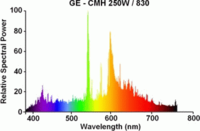
Photo from wikipedia
Soft X-ray emissions, which originate from electronic transitions from valence bands (bonding electron states) to inner-shell electron levels, inform us energy states of bonding electrons if those energies are analyzed… Click to show full abstract
Soft X-ray emissions, which originate from electronic transitions from valence bands (bonding electron states) to inner-shell electron levels, inform us energy states of bonding electrons if those energies are analyzed with an energy resolution better than 1 eV. Thus, soft-X-ray emission spectroscopy (SXES) based on electron microscopy should be a hopeful method to evaluate bonding states of identified small specimen areas. SXES can apply to metal, semiconductor and insulator materials under a conventional vacuum condition of electron microscopes. One drawback is its low detection efficiency. Then, a commercial SXES spectrometer, which was composed of varied line spacing (aberration corrected) gratings and an area detector, was designed as an attachment for EPMA/SEM [1], which can use a larger probe current than that of TEM. As EPMA/SEM are operated at a lower accelerating voltage than that of TEM, bonding states of irradiation sensitive materials can be investigated. Here, SXES imaging of chemical state mapping of carbon atoms of amorphous carbon nitride (a-CNx) films and diamond like carbon (DLC) films are presented [2,5].
Journal Title: Microscopy and Microanalysis
Year Published: 2019
Link to full text (if available)
Share on Social Media: Sign Up to like & get
recommendations!